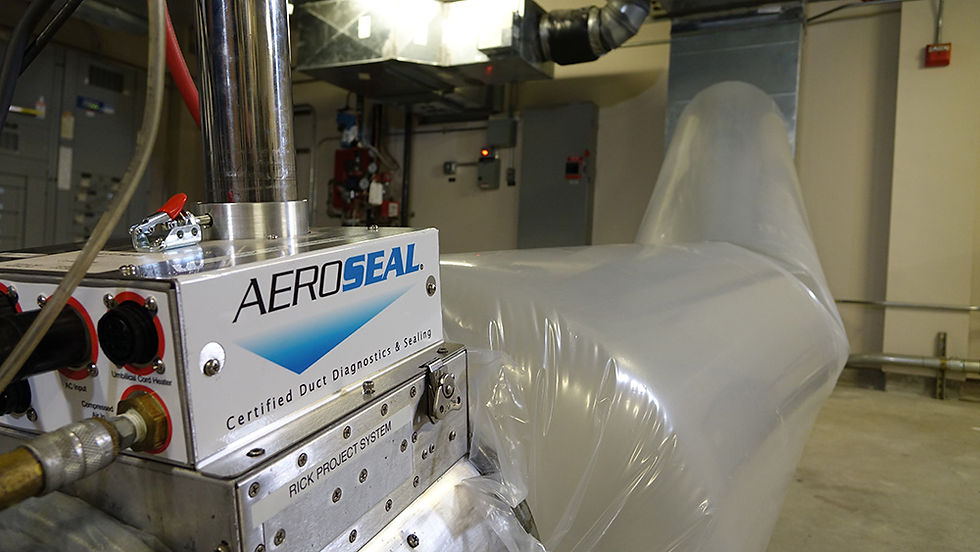Why Choose MediClean's HVAC Cleaning Process?
- MediClean Air Pros

- May 2, 2021
- 4 min read
Updated: Jun 19, 2021
MediClean uses the source removal process for all of our HVAC cleaning projects. Read more to find out why source removal is the most effective way to remove contaminants from your system.

Thoroughly Clean
While there are several methods of cleaning the ductwork in your home or office, some ways are more effective and thorough than others. The purpose of cleaning an air duct is to remove the dust, dirt, debris and allergens from the system, and to keep these from circulating through your living or workspace. The definition of a clean HVAC system is one that is free of any loose particulate matter that may become airborne and contaminate the space. By definition, an HVAC system that has debris remaining after the cleaning process is not thoroughly clean.
The MediClean Difference
MediClean’s cleaning process is the Source Removal method. This method puts the system under negative pressure and uses a device to agitate particulate matter within the system that is then vacuumed into the collection device. NADCA standards require that any system being cleaned is put under negative pressure. The purpose of the negative pressure is to ensure that no particulate is broadcast from the duct system into the living or conditioned space.
When an HVAC system is put under negative pressure, an eight-inch hose is attached to the system and a large volume of air is pulled through. This air is pulled from the home or office into the duct system and out into the collection device. The negative airflow keeps dust and debris contained within the system. With this method, as the contaminants are agitated and removed from the interior surfaces, they are simultaneously being pulled into the HEPA filtered vacuum or into the vacuum outside. Putting the system under negative pressure is similar to using a straw to drink water - when the straw goes into one’s mouth, the entirety of the water can be drawn into the straw. In the same way when a duct system is completely contained and negatively pressurized, then all of the air and particulate will be removed effectively.
In conjunction with the negative pressure, a true source removal method uses an agitation device to loosen the particulate and move it towards the collection device. There are various types of agitation devices, and when used properly, all can be effective. These include: air whips, rotating brushes, and air nozzles - all which may be used to agitate and loosen dust and debris within your system. The key to proper use of these devices is that the agitation must be applied towards the source of the negative pressurization. This way, all contaminants within the system remain in front of the device and are pushed towards the collection container. Ensuring that the total length of every line is contacted by the agitating device guarantees that the lines will be clean once the process is complete. These devices are attached to a series of stiff whip rods which will bend with the ductwork, but will also ensure that the entire length of each line is contacted - all the way back to the furnace.
MediClean uses each of these methods to ensure that the entirety of your system is clean and that your efficiency and indoor air quality is greatly improved.
Other Methods
The Rotobrush method with no negative pressurization is another tool companies use to clean HVAC systems. We at MediClean have found that this is a much less effective way to guarantee thorough, lasting results, and the process of negative pressurization is the best option for a clean, healthy indoor environment both during and after cleaning.
While the Rotobrush does have an agitation device attached to the end of the vacuum hose, the process itself poses a few issues. First, the vacuum hose pulls air in from behind the brush, which is essentially pulling particulate down towards the vent opening instead of out towards the collection device. Second, it is difficult for all of the particulate and debris to get through the brush head and into the vacuum hose simply due to the nature of a brush. Dust and debris can stick to the outside of the brush and this also may result in a pile of debris left on the non-vacuum side of the brush. Again, if the system were maintained under negative pressure, this would help eliminate this issue. Third, the vacuum hose itself is problematic. A hose is not the optimal device to push through ductwork because air ducts vary in texture and often have sharp turns which make it difficult or impossible to navigate the vacuum hose through. Often the Rotobrush method will only clean 6 to 10 feet of the length of the duct line, and there are very few lines that are only 6 to 10 feet in length. Because of this, the Rotobrush may leave a substantial part of the line that is not clean, which adds up to a large portion of the system that still remains dirty. All of the particulate that the Rotobrush process leaves in your lines will blow back through and recontaminate your entire system and home.
Choose the Pros
MediClean is NADCA certified and employs highly trained technicians, many of which are ASCS (Air System Cleaning Specialists). It is clear to see the importance of researching the correct air duct cleaning methods before spending your money and time on the project. Source removal, negative pressurization and correct cleaning tools are just a few ways to ensure that your home or office is cleaned correctly.





Working alongside HVAC contractors in Riviera Beach has been a seamless experience. Their team is knowledgeable, responsive, and always up-to-date with the latest HVAC technologies and practices. They are our go-to experts for any heating, cooling, or ventilation needs,